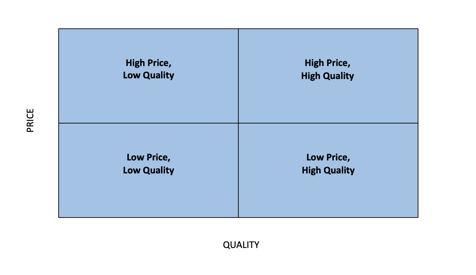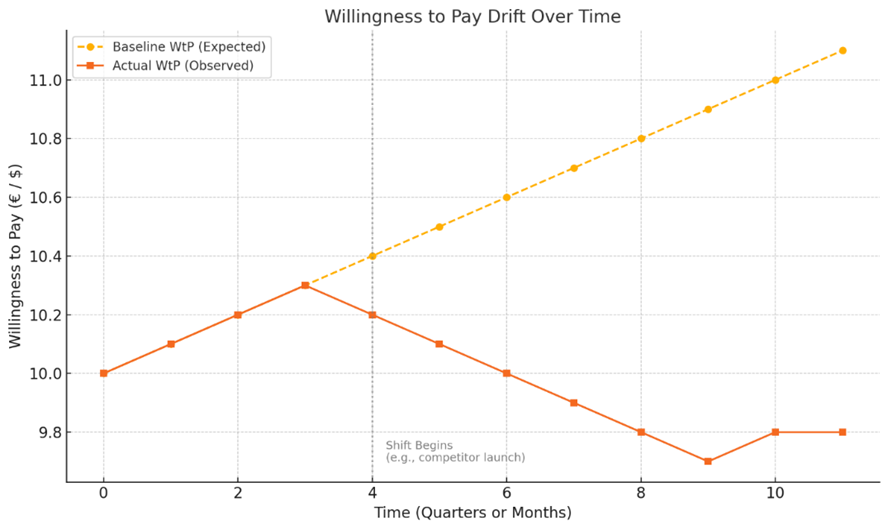What does your Price Positioning say about your Brand?
 PriceBeam
·
4 minute read
PriceBeam
·
4 minute read

Your brand is your promise to your customers. It’s what they are expecting from you when buying your goods or services. Pricing is just as important to brand equity as other differentiators, as one function of a price is that it conveys a quality message and therefore, can influence the conceptual place your brand takes in the target consumer’s mind.
As your brand’s promise is not explicit, we often see businesses underpricing, or overpricing because they don’t know exactly what they are communicating to their customers.
Price positioning is the act of placing a price on a product or service that is within a certain price range. The price positioning indicates where a product sits in relation to its competitors in a certain market as well as in the mind of different customers. Price positioning also has an impact on whether a product is seen as cheap (low price) or not (high price). A way to visualize this is using a price-value matrix.(below)

The position of your products within the matrix is based on your brand promise, competition and your pricing objectives. A different position and a different price point result in the targeting of a different consumers.
Positioning statements are for internal use. These statements guide the marketing and operating decisions of your business. A positioning statement helps you make key choices that affect your customer’s perception of your brand.
Price positioning is essential to companies that are trying to convince customers to buy a product or service. If a company is trying to sell budget smartphones, it needs to keep their prices low enough so that matches its price positioning. On the other hand, if a brand’s positioning pivots around the aspects of “being premium” or wants to be perceived as a luxurious brand, it needs to price the products in a way that matches those claims.
The most important takeaway from this is that consistency is key and companies can implement a variety of pricing strategies and pricing tactics to maintain that level of consistency. A price position gives the product a unique selling propostion and makes that product stand out from its competitors. Adding to that, a price position is also ideal when the business can charge a higher price and fend off the competition.
Knowing you are working on the positioning, there are different strategies that will allow you to position your products and services according to your chosen position. Some of which we will describe below.
1) Economy Pricing
Businesses that can sustain lower overheads and costs than their competitors might find using an economy Pricing strategy very effective, as their low cost base allows them to sell at a discount price so that they can gain a high market share. Small businesses are less likely to use this positioning strategy as they might struggle to achieve the volume of sales needed to remain profitable selling at the lowest price in the market. Selling a similar product or service at a lower price can help undercut market competitors and gain a competitive advantage.
One of the marketing challenges is for customers to perceive that your price is the lowest compared to the competition in the market. Another disadvantage of this strategy is that you're susceptible to more competition, as economy customers are always looking for the ´best deals´ and therefore you will not achieve customer loyalty with economy pricing.
Finally, there is only room for one winner of the "lowest price" label in the market place.
2) Price Skimming
Price skimming is the act of setting the price of a product or service high enough so that certain customers are skimmed. Companies price their products higher than what their competitors are offering to skim off customers who are willing to pay more. This strategy is effective only if businesses make sure their customers understand why they are paying more for a particular product. Price skimming is often used in markets that have a high level of new product launches. Setting an initial high price allows for covering production costs and initial product development costs. On the other hand, dropping the price later might annoy customers that paid a premium for the product when it was launched and might damage loyalty towards your brand.
3) Competitive Pricing
There are a few different ways a company can use competitive pricing for price positioning. It can match the price of a competitor's offering or it can change the offering so that the business gives itself an advantage over its competitors. For companies to match their competitors offer, they can set the price of their product to something that is comparable to their competition. Companies can also 'surround' their competition, which involves surrounding the middle market. This involves having the cheapest product or service option on the market, but also adding options that are closer to their competitors' initial offerings.
Another method involves undercutting a competitor's prices in some categories. Companies can do this by offering a price that is similar to their competition and another price that is lower than their competitor's price. There are pros and cons associated with being the low-priced option in a particular market, but the strategy is great for getting a customer interested in a product or service. While it does encourage customers to try their products, this strategy lowers margins and can also set a poor precedent for a business.
4) Penetration Pricing
This strategy is the fastest way to win market share from competitors and to then secure it against new rivals. It focuses on setting an initial low price and then increasing it by switching to skimming or premium pricing strategies. It relies on consumers valuing your brand and therefore switching to your low priced , ´high quality´ product, allowing the business to penetrate the market. A challenge is that setting a price which is too low can damage your brand as it might start to be perceived as low quality. This Pricing strategy is successfully used when launching products in markets where demand tends to fluctuate notably as prices change, as the ´price elasticity allows businesses to launch products at a lower price to compete with market rivals.
5) Premium Pricing
Businesses with high brand consideration might finding premium pricing helps them achieve a higher margin. A high price has to be justified by offering a ´premium´ product. Although setting a high price doesn't signalises a product as ´premium´ or luxurious, it might enhance your brand identity and value perception of your brand if marketed correctly. Risks of under-delivering the premium you offer can destroy your profits, especially as you are likely to be undercut by competitors in the market.
Pricing strategy needs to accurately understand the Wiliness-to-Pay of a consumer, which, in turn, reflect the brand’s equity and value perception in the minds of the consumer. An firm pricing strategy can have a positive effect on brand equity, while a poor strategy can lead to the opposite.
Conclusion
In most markets the price positiioning has a strong impact on how the brand is perceived. In the end, it is all about how customers see the brand and what they are willing to pay.
Using willingness-to-pay insights from market research, you can pin point the optimal price points. But by enhancing the brand value the above curves will move. If working on branding and positioning, make sure to track the changes in customers' willingness-to-pay over time, e.g. every 3 or 6 months.
PriceBeam provides willingness-to-pay insights in 109 countries and you can have results in less than 72 hours for 1/10th of the cost of old-fashioned market research. Get in touch or book a free demo to see how your business can benefit.
.png?width=400&height=100&name=PBLogoTransparent%20(1).png)



